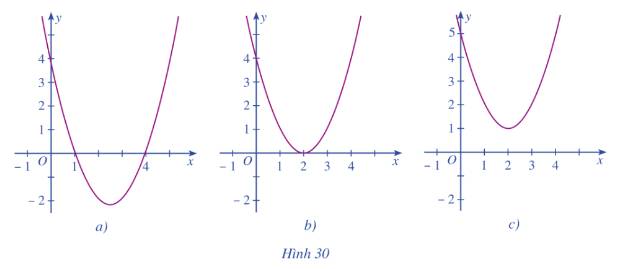Từ tập \(X=\left\{0;1;2;3;4;5\right\}\) có thể lập được bao nhiêu số tự nhiên có 3 chữ số đôi một khác nhau mà số đó chia hết cho 5
Hãy nhập câu hỏi của bạn vào đây, nếu là tài khoản VIP, bạn sẽ được ưu tiên trả lời.


Ta có: \({x^2} - 6 = 0 \Leftrightarrow x = \pm \sqrt 6 \in \mathbb{R}\)
Vì \(\sqrt 6 \in \mathbb{R}\) và \( -\sqrt 6 \in \mathbb{R}\) nên \( A = \left\{ { \pm \sqrt 6 } \right\}\)
Nhưng \( \pm \sqrt 6 \notin \mathbb{Z}\) nên không tồn tại \(x \in \mathbb{Z}\) để \({x^2} - 6 = 0\)
Hay \(B = \emptyset \).

a) Phương trình: \({x^2} - 3x + 2 = 0\,\,\,\left( 1 \right)\)
Ta có: \(\Delta = 9 - 4.2 = 1 > 0\)
Phương trình (1) có hai nghiệm \(\left\{ \begin{array}{l}{x_1} = \frac{{3 + 1}}{{2.1}} = 2\\{x_1} = \frac{{3 - 1}}{{2.1}} = 1\end{array} \right.\) => \({S_1} = \left\{ {1;2} \right\}\)
Phương trình: \(\left( {x - 1} \right)\left( {x - 2} \right) = 0\,\,\,\left( 2 \right)\)\( \Leftrightarrow \left[ \begin{array}{l}x = 1\\x = 2\end{array} \right.\) => \({S_2} = \left\{ {1;2} \right\}\)
b) Hai tập \({S_1};{S_2}\) có bằng nhau

a: \(\Leftrightarrow\left[{}\begin{matrix}x+5=0\\2x-3=0\end{matrix}\right.\Leftrightarrow\left[{}\begin{matrix}x=-5\\x=\dfrac{3}{2}\end{matrix}\right.\)
b: \(\Leftrightarrow\left(x-3\right)\left(x+3\right)\left(x-4\right)=0\)
\(\Leftrightarrow\left[{}\begin{matrix}x=3\\x=-3\\x=4\end{matrix}\right.\)
c: \(\Leftrightarrow\left[{}\begin{matrix}2x+3=0\\5x-4=0\end{matrix}\right.\Leftrightarrow\left[{}\begin{matrix}x=-\dfrac{3}{2}\\x=\dfrac{4}{5}\end{matrix}\right.\)
d: \(\Leftrightarrow\left(x+3\right)\left(x-4\right)=0\)
=>x+3=0 hoặc x-4=0
=>x=-3 hoặc x=4
e: \(\Leftrightarrow\left(x-3\right)\left(x+3\right)\left(x-4\right)=0\)
\(\Leftrightarrow\left[{}\begin{matrix}x=3\\x=-3\\x=4\end{matrix}\right.\)
f: \(\Leftrightarrow\left(2x+3\right)\left(x-4\right)\left(x+4\right)=0\)
hay \(x\in\left\{-\dfrac{3}{2};4;-4\right\}\)
a, \(\Leftrightarrow\left[{}\begin{matrix}x+5=0\\2x-3=0\end{matrix}\right.\Leftrightarrow\left[{}\begin{matrix}x=-5\\x=\dfrac{3}{2}\end{matrix}\right.\)
b, \(\Leftrightarrow\left[{}\begin{matrix}x^2-9=0\\4-x=0\end{matrix}\right.\Leftrightarrow\left[{}\begin{matrix}x=\pm3\\x=4\end{matrix}\right.\)
c, \(\Leftrightarrow\left[{}\begin{matrix}2x+3=0\\4-5x=0\end{matrix}\right.\Leftrightarrow\left[{}\begin{matrix}x=-\dfrac{3}{2}\\x=\dfrac{4}{5}\end{matrix}\right.\)
d, \(\Leftrightarrow\left[{}\begin{matrix}x+3=0\\x-4=0\end{matrix}\right.\Leftrightarrow\left[{}\begin{matrix}x=-3\\x=4\end{matrix}\right.\)
e, tương tự d
f, \(\Leftrightarrow\left[{}\begin{matrix}2x+3=0\\x^2-16=0\end{matrix}\right.\Leftrightarrow\left[{}\begin{matrix}x=-\dfrac{3}{2}\\x=\pm4\end{matrix}\right.\)

Hình 30a:
\(f\left( x \right) > 0\) có tập nghiệm là \(S = \left( { - \infty ;1} \right) \cup \left( {4; + \infty } \right)\)
\(f\left( x \right) < 0\) có tập nghiệm là \(S = \left( {1;4} \right)\)
\(f\left( x \right) \ge 0\) có tập nghiệm là \(S = \left( { - \infty ;1} \right] \cup \left[ {4; + \infty } \right)\)
\(f\left( x \right) \le 0\) có tập nghiệm là \(S = \left[ {1;4} \right]\)
Hình 30b:
\(f\left( x \right) > 0\) có tập nghiệm là \(S = \mathbb{R}\backslash \left\{ 2 \right\}\)
\(f\left( x \right) < 0\) có tập nghiệm là \(S = \emptyset \)
\(f\left( x \right) \ge 0\) có tập nghiệm là \(S = \mathbb{R}\)
\(f\left( x \right) \le 0\) có tập nghiệm là \(S = \left\{ 2 \right\}\)
Hình 30c:
\(f\left( x \right) > 0\) có tập nghiệm là \(S = \mathbb{R}\)
\(f\left( x \right) < 0\) có tập nghiệm là \(S = \emptyset \)
\(f\left( x \right) \ge 0\) có tập nghiệm là \(S = \mathbb{R}\)
\(f\left( x \right) \le 0\) có tập nghiệm là \(S = \emptyset \)

a) \(A = \{ 3;2;1;0; - 1; - 2; - 3; -4; ...\} \)
Tập hợp B là tập các nghiệm nguyên của phương trình \(\left( {5x - 3{x^2}} \right)\left( {{x^2} + 2x - 3} \right) = 0\)
Ta có:
\(\begin{array}{l}\left( {5x - 3{x^2}} \right)\left( {{x^2} + 2x - 3} \right) = 0\\ \Leftrightarrow \left[ \begin{array}{l}5x - 3{x^2} = 0\\{x^2} + 2x - 3 = 0\end{array} \right.\\ \Leftrightarrow \left[ \begin{array}{l}\left[ \begin{array}{l}x = 0\\x = \frac{5}{3}\end{array} \right.\\\left[ \begin{array}{l}x = 1\\x = - 3\end{array} \right.\end{array} \right.\end{array}\)
Vì \(\frac{5}{3} \notin \mathbb Z\) nên \(B = \left\{ { - 3;0;1} \right\}\).
b) \(A \cap B = \left\{ {x \in A|x \in B} \right\} = \{ - 3;0;1\} = B\)
\(A \cup B = \) {\(x \in A\) hoặc \(x \in B\)} \( = \{ 3;2;1;0; - 1; - 2; - 3;...\} = A\)
\(A\,{\rm{\backslash }}\,B = \left\{ {x \in A|x \notin B} \right\} = \{ 3;2;1;0; - 1; - 2; - 3;...\} {\rm{\backslash }}\;\{ - 3;0;1\} = \{ 3;2; - 1; - 2; - 4; - 5; - 6;...\} \)

\(mx^2-4x+m-3=0\left(1\right)\)
Để tập hợp B có đúng 2 tập con và \(B\subset A\) thì \(\left(1\right)\) có 2 nghiệm phân biệt cùng dương
\(\left(1\right)\Leftrightarrow\left\{{}\begin{matrix}\Delta'>0\\P>0\\S>0\end{matrix}\right.\)
\(\Leftrightarrow\left\{{}\begin{matrix}4-m\left(m-3\right)>0\\\dfrac{m-3}{m}>0\\\dfrac{4}{m}>0\end{matrix}\right.\)
\(\Leftrightarrow\left\{{}\begin{matrix}m^2-3m-4< 0\\m< 0\cup m>3\\m>0\end{matrix}\right.\)
\(\Leftrightarrow\left\{{}\begin{matrix}-1< m< 4\\m< 0\cup m>3\\m>0\end{matrix}\right.\)
\(\Leftrightarrow3< m< 4\)
Ta có:
\(\overrightarrow{AG}=\overrightarrow{AB}+\overrightarrow{BG}\)
+) \(\overrightarrow{BG}=\dfrac{1}{3}\left(\overrightarrow{BM}+\overrightarrow{BN}\right)=\dfrac{1}{3}\left(-\dfrac{2}{3}\overrightarrow{AB}+\overrightarrow{BC}+\overrightarrow{CN}\right)\)
\(=\dfrac{1}{3}\left(-\dfrac{2}{3}\overrightarrow{AB}+\overrightarrow{AC}-\overrightarrow{AB}-\dfrac{1}{2}\overrightarrow{DC}\right)=\dfrac{1}{3}\left(-\dfrac{13}{6}\overrightarrow{AB}+\overrightarrow{AC}\right)\)
\(=-\dfrac{13}{18}\overrightarrow{AB}+\dfrac{1}{3}\overrightarrow{AC}\)
=> \(\overrightarrow{AG}=\dfrac{5}{18}\overrightarrow{AB}+\dfrac{1}{3}\overrightarrow{AC}\)
Mặt khác:
\(\overrightarrow{AI}=\overrightarrow{AB}+\overrightarrow{BI}=\overrightarrow{AB}+k\overrightarrow{BC}=\overrightarrow{AB}+k\left(\overrightarrow{AC}-\overrightarrow{AB}\right)=\left(1-k\right)\overrightarrow{AB}+k\overrightarrow{AC}\)
Để A, G, I thẳng hàng
=>\(\dfrac{\dfrac{5}{18}}{1-k}=\dfrac{\dfrac{1}{3}}{k}\Rightarrow k=\dfrac{6}{11}\)

\(f\left(x\right)=x+\dfrac{\sqrt{x}}{x+1}\Rightarrow f'\left(x\right)=1+\dfrac{1-x}{2\sqrt{x}\left(x+1\right)^2}\)
\(f'\left(x\right)-1>0\Leftrightarrow\dfrac{1-x}{2\sqrt{x}\left(x+1\right)^2}>0\)
\(\Rightarrow0< x< 1\)

Gọi số đó là \(\overline{abc}\)
TH1: \(c=0\Rightarrow\) bộ ab có \(5.4=20\) cách chọn
TH2: \(c=5\Rightarrow\) bộ ab có \(4.4=16\) cách chọn
Tổng cộng: \(20+16=36\) số thỏa mãn